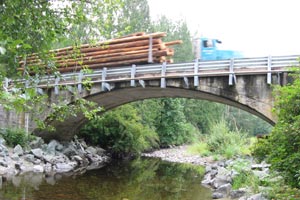Rural America Needs Road, Bridge Overhaul, Report Says

Rural American communities also have transportation needs and suffer from dilapidated roads and bridges, says a report from TRIP, a nonprofit transportation research group.
Executives from AAA, a farmers trade group and another for domestic U.S. tourism backed the report’s findings during a May 19 press conference and asked Congress to pass a long-term surface transportation bill financed with higher fuel taxes.
The study reported large stretches of run-down pavement on roads outside of metropolitan areas and a large number of structurally deficient bridges. Arising in large part from the poor infrastructure, fatal crashes per vehicle-miles driven in rural areas were found to far outnumber rates on other roads.
“Without an efficient transportation system, vibrant rural communities cannot exist,” economist Veronica Nigh of the American Farm Bureau Federation said during the press conference.
Farmers need a “three-legged stool” of transportation made up of roads for trucks, freight railroads and waterways for barges, Nigh said. Trucks bring necessary inputs, including seed, fertilizer and parts for equipment. She also said they are critical for hauling away crops and livestock.
Kathleen Bower, a AAA vice president, said the nation is on the verge of “an imminent funding crisis” for the federal Highway Trust Fund. She urged members of both houses of Congress to “make the tough call and take the tough vote” to increase gasoline and diesel taxes at the pump.
With “potholes the size of craters” a common sight, Bowers urged legislators to produce a long-term surface transportation plan. She also criticized Congress for producing numerous short-term patches for the trust fund rather than a multiyear plan, calling the short-term fixes “economically irresponsible.”
The report gave assessments of rural paving quality, structurally deficient bridges and fatality rates for all 50 states based on a 2013 survey.
Overall, 15% of the nation’s rural roads, not including interstate highways, were rated as having pavement in poor condition. The five worst states were Michigan, 37% of pavement in poor condition; Rhode Island, 32%; Hawaii and Idaho, 31% each; and Kansas, 30%.
Earlier in May, Michigan voters strongly rejected a sales tax increase that would have pumped more money into state road repairs.
Using 2014 data, 11% of rural bridges were structurally deficient and 10% were functionally obsolete, the report said.
A structurally deficient bridge is one that needs improvement but is not so damaged it is considered unsafe.
The four worst states for bridges were Pennsylvania, with 25% of rural bridges declared structurally deficient; Rhode Island, 23%; Iowa, 22%; and South Dakota, 21%.
Iowa’s Legislature and governor agreed on a transportation package earlier this year to increase repairs and pay for the work with higher fuel taxes.
Highway fatalities, among all vehicle types, were adjusted for 100 million vehicle-miles traveled. In 2013, the rural fatality rate, not including interstate highways was 2.2 deaths per 100 million miles.
The five worst states were Connecticut, 3.57 rural versus 0.59 on all other roads; South Carolina, 3.4 rural versus 0.69 other; Florida, 3.2 versus 0.96; Montana, 3.09 versus 0.76; and Arizona, 3.01 versus 1.15.
Rocky Moretti, TRIP’s director of research and policy, said rural roads have problems relative to urban highways, such as “roadway features that reduce safety, including narrow lanes, limited shoulders, sharp curves, exposed hazards, pavement drop-offs, steep slopes and limited clear zones along roadsides.”

